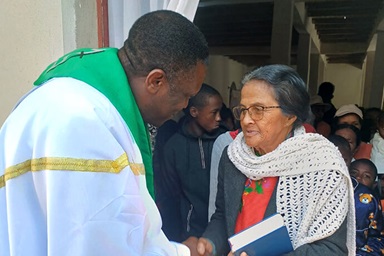In Zimbabwe, being pregnant and giving birth can be life threatening.
A variety of factors — including lack of access to professional prenatal care, delays in seeking or reaching health care, poor monitoring of pregnancy or possibly having malaria — all increase the likelihood that a woman may die during pregnancy, during delivery or shortly after delivery.
In an effort to reduce the maternal mortality rate, Old Mutare Mission Hospital has begun performing Caesarian-section surgeries for women with high-risk pregnancies.
With the Caesarian deliveries, the hospital hopes to prevent maternal mortality in the area, said Dr. Tendai Manyeza, the hospital’s medical superintendent.
“The hospital previously referred all patients that required Caesarian section to Mutare General Hospital, 17 kilometers away,” he said. “This new service will see patients needing a Caesarian section being attended to quickly instead of being referred to Mutare.”
Hannah Mafunda, health board coordinator, said Zimbabwe’s Ministry of Health and Child Care was “very instrumental in seeing this dream come true.”
According to the World Health Organization, Zimbabwe’s maternal mortality ratio declined from 960 deaths per 100,000 live births in 2010 to 614 in 2014. Zimbabwe’s target was to reduce that rate to 71 deaths per 100,000 live births in 2015.
Section Heading
The Health Systems Strengthening Program supports United Methodist hospitals and healthcare efforts around the world. Give to Advance #982168.
An Imagine No Malaria grant will be used to build a new maternity waiting shelter. Donate to Imagine No Malaria.
Expansion needed
Old Mutare Hospital is a United Methodist institution located in the Mutasa District of Manicaland Province, in the eastern part of Zimbabwe — about 2 kilometers, or just over a mile ─ from Africa University. It serves a surrounding population of about 15,000, mainly from nearby rural areas, nearby schools and Africa University, with some patients coming from beyond these areas. Outside the district, the hospital supervises six United Methodist rural health centers through monthly administrative and treatment visits.
The hospital conducts about 600 deliveries per year. The hospital provides prenatal, postnatal and services for children under 5. The government of Zimbabwe has tried to improve maternal health by offering free access to health care for pregnant women and children under the age of 5.
It has a 30-bed maternity unit with operating room, antenatal ward, postnatal ward, a family and child unit, and a 12-bed waiting mothers’ shelter that is always full.
The maternity waiting shelter houses mothers with difficulties getting health care. Maternity waiting shelters are established in rural areas for women who live far from the health facilities and where transport is poor and at times not available. These women stay at the shelter to await the onset of labor. Women are admitted to a waiting home at 36 weeks of pregnancy. Normal delivery is at 38 to 40 weeks.
By implementing a maternity waiting shelter, the hospital hopes to prevent maternal death by improving access to skilled birth attendance and emergency obstetric care, for women in remote areas.
The shelter has three rooms designed to accommodate 12 waiting mothers, but often holds 20-30 mothers due to the high volume of pregnant women in need of this service.
“Our shelter has become too small for the demand and we have plans to build a bigger shelter,” Manyeza said.
Mafunda explained that, through the Episcopal Health Board, funding has been secured from Imagine No Malaria to construct a state-of-the-art maternity waiting shelter at the hospital. The bids for tenders have already been circulated, interviews were conducted and construction will start soon.
Further improvements
During the Zimbabwe East Annual Conference’s 15th session, Bishop Eben Nhiwatiwa dedicated an ambulance donated by the Zimbabwean government through Ministry of Health and Child Care. Dr. Panganai Mutsaa, a new doctor seconded to the hospital by the government, explained that the ambulance will aid in preventing the delay of referrals to hospital from clinics.
A grant from the United Methodist Board of Global Ministries helped the hospital purchase a washing machine, dryer and roller iron, which will alleviate linen shortages.
The hospital has also installed a solar system donated by United Methodist Women.
“This has improved lighting of the hospital in these days of frequent power cuts,” said Mutsaa.
Per recommendation by the Provincial Environmental Health Officer, the hospital has constructed an incinerator, which Mafunda said “will compliment functionality of the (operating) theatre in terms of waste management and infection control.”
The conference health board reported to the annual conference session that Old Mutare hospital had no maternal deaths in the past two years.
“We will endeavor to continue improving the quality of our care so that we maintain a zero maternal death,” said Manyeza.
Muzerengwa is a communicator for Zimbabwe East Annual Conference.
News media contact: Vicki Brown, news editor, [email protected] or 615-742-5470.
Like what you're reading? Support the ministry of UM News! Your support ensures the latest denominational news, dynamic stories and informative articles will continue to connect our global community. Make a tax-deductible donation at ResourceUMC.org/GiveUMCom.




